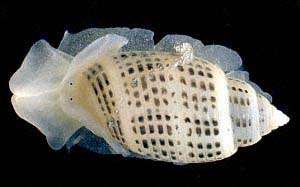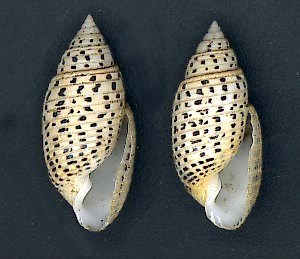

Japonacteon suturalis
(A. Adams, 1855)
Order: CEPHALASPIDEA
Superfamily: ACTEONOIDEA
Family: Acteonidae
DISTRIBUTION
Tropical Indo-West Pacific.
PHOTO
UPPER: Kunduchi Beach, Dar es Salaam, Tanzania, July 1973. LOWER: Shells, Roebuck Bay, Broome, NW Australia on sandy mudflats, October 1972, AM C46379, 19mm high. PHOTOS: Bill Rudman
There are a number of similarly coloured acteonids found in tropical waters and if you carefully examine lots of shells in museums collections you will often find there are two or three species with black-spotted white shells mixed together. They all have a spiral pattern of black spots and can often be found living together. The two most common species mistaken for Japonacteon suturalis are Pupa strigosa (Gould, 1859) and Pupa solidula . All of these species are found burrowing shallowly through sand and feed on a variety of polychaete worms.
This species differs from the species of Pupa in having a channeled groove along the suture and a single fold on the columella.
Reference:
• Adams, A., (1855) (for 1854). Monographs of Actaeon and Solidula, two genera of gasteropodous mollusca with descriptions of several new species from the Cumingian collection. Proceedings of the Zoological Society of London,22: 58-62.
Rudman, W.B., 1998 (December 18) Japonacteon suturalis (A. Adams, 1855). [In] Sea Slug Forum. Australian Museum, Sydney. Available from http://www.seaslugforum.net/find/japosutu
Related messages
Japonacteon suturalis found sthn Queensland
May 13, 2009
From: Gary

Concerning message #4587:
Hi Bill and everyone!
David and I have started out quest to find all the Bubble shells (hopefully with live animals) here in our area. We have raided the kitchen and taken only the finest sieve we could find.
We have been doing a lot of searching in the sand just off Bulwer beach Moreton Island and are finding new species every trip, and in places we would not expect! With each sieve of the fine white sand we are collecting many shells. Japonacteon suturalis is quite a surprise and there were two.
Locality: Moreton Island, 2.5 m, Queensland, Australia, Pacific Ocean, 09 May 2009, Subtidal. Length: 4 mm crawling. Photographer: Gary Cobb.
Cheers
Gary
gary@nudibranch.com.au



Dear Gary,
Thanks for these photos. At less than 4 mm in length I think your fine seive is the only way you would have found these juveniles. Apart from the shell characters I mention on the Fact Sheet I can see one other external character in your photos which helps distinguish this from Pupa strigosa and Pupa solidula, which also have white shells with black spots. The anterior corners of the foot are extended into short tentacular processes. By comparison, the anterior foot corners in species of Pupa, are rounded. I have enlarged and over-brightened the front end of one of your photos to show this.
I always found these animals difficult to 'pose' for photographs on a smooth surface. They seem to miss the soft sand in which they usually live.
Best wishes,
Bill Rudman
Questions about Japonacteon suturalis
June 15, 2001
From: Alexander Martynov
Dear Bill,
Can I ask you about Japonacteon suturalis, that excellent photo I have found on the Forum? I have some problems regarding this species.
In his first description of Solidula suturalis Adams noted that "the colour varies from pure white to greyish, with grey tessellated margins." Type locality only as Island of Luzon, from Mus. Cuming. Later Reeve in 1865 (Conch. Icon.) recorded this species under name Tornatella suturalis Adams, MS. in Mus. Cuming and mentioned two different sources of material:
Japan; Adams and Puerto Galero, Island of Mindoro, Philippines; Cuming, although Adams in first description mentioned only Luzon Id.
Reeve pictured two colour morphs: first with many little dense spots (figs. 9a, 9b), second with at least one broad white band in middle of shell (fig. 9 c). Reeve doesn't mention from which place each form exactly come. For me the identity of J. suturalis is very interesting because we study Japonacteon nipponensis from Peter the Great Bay and have some materials from Japan and China, which are sometimes varied greatly in colour pattern. Your J. suturalis have clear bands. How you sorted these characters from the very unclear first description? Did you see the type material of S. suturalis? In Japanese literature I came across pictures of J. nipponenis very similar to those in Reeve (fig. 9a, b , but not 9c). Pupa suturalis was noted for Japanese fauna only once (Kuroda, Habe, 1952, Pacific side, cited by Higo, Callomon, Goto, 1999), without illustration, as I understand.
Does your J. suturalis always have similar colour pattern or does it sometimes vary? As far as I understand, the combination of Japonacteon suturalis appeared for a first time in the Forum? We don't have your paper - 1971c. The family Acteonidae (Opisthobranchia, Gastropoda)in New Zealand. J. Malacol. Soc. Australia, 2(2): 205-14.
I checked Zoological Record and found out, that at least in Z.R. for this paper not mentioned genus Japonacteon and Pupa suturalis. That is why I began to think that Japonacteon suturalis is virtually comb. nov. in the Forum. Maybe I missed some of your publications?
Excuse me, if my letter and questions are onerous,
Yours sincerely,
Alexander Martynov
Laboratory of Marine Researches
Zoological Institute RAS
St. Petersburg, Russia
martyn@AM3963.spb.edu
Martynov, A., 2001 (Jun 15) Questions about Japonacteon suturalis. [Message in] Sea Slug Forum. Australian Museum, Sydney. Available from http://www.seaslugforum.net/find/4587
Dear Alexander,
Thanks for the question. The acteonids were the first opisthobranchs I ever studied so it is nice to return to them now and again. The animal I have identified as Japonacteon suturalis has a white shell with black spots. Sometimes there are white bands, like in the photo of the living animal from Tanzania, but often the black spots form a uniform covering as on these shells from northwestern Australia. I have examines the radula from a range of colour forms from across the Indo-West Pacific and it always the same.
Adams description of the shell color, in Latin, could probably apply to other black-spotted species such as Pupa strigosa and even Pupa solidula. However Adams' accompanying comments in English provide the clue to its identity.
"In this species the blind tubercle usually present in Solidula is wanting; the colour varies from pure white to greyish with grey tesselated markings; the chief peculiarity of the species consists, however, in the canaliculated suture of the whorls' - Adams, 1855 (for 1854) p 61 Proc. zool. Soc. Lond., 22: 58-62
The two features which distinguish this species from other black-spotted Pupa-like shells are the single fold on the columella and the deeply channelled suture (the deep groove where the inner lip of the shell is attached to the body of the shell). This is almost certainly the reason for its name suturalis.
I think my use of the genus name Japonacteon for this species in the Forum was the first usage. Some will be concerned that I did not publish it on paper, but I have lots of background information I have accumulated over many years. I suspect I will never have time to publish it on paper so I am certain it is more useful on the Forum than in a forgotten file in my room. The radular morphology of this species is identical to Taki's description of Japonacteon nipponensis (Yamakawa, 1911), and the shell has a simple columellar fold.
One difference in the anatomy is that Taki suggests that the stomach in his species is a one way system with the oesophagus entering at one end and the intestine leaving at the other. I suspect he may have made an error because all acteonids that I have dissected, and related speces of Bullina and Hydatina, have the oesophageal and intestinal openings together at one end of the stomach, which is functionally a blind sac.
I have included an illustration of the radula of J. suturalis in a separate message.
Of course it is alwayd possible that
Reference:
• Taki I., (1956) Japonacteon, a new genus of Pupidae (Opisthobranchia, Gastropoda). Bulletin of the National Science Museum, Tokyo, 3(1): 47-51
Best wishes,
Bill Rudman
Japonacteon suturalis radula
June 15, 2001
From: Bill Rudman

To accompany my comments to Alexander about Japonacteon suturalis here is a pencil sketch I made with the aid of a camera lucida, [pre-SEM days], of the radula of a specimen collected at Armstrong Bch, nr Mackay, Queensland, Australia (Aust Museum AM C69768).
The formula is 6.0.6 with the first tooth on each side of the midline having a reduced cusp with large denticles. Teeth 2-5 have a long pointed cusp with one or two basal denticles on the outside, and Tooth 6 is reduced to a small plate. This is identical to Taki's drawing of the radula of Japonacteon nipponensis, the type of the genus. Compare this with the the radula of P. solidula typical of the genus Pupa in which all the teeth are similar in size and shape.
Best wishes,
Bill Rudman
